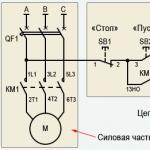The periodic law, one of the fundamental laws of natural science, was discovered by the great Russian scientist D.I. Mendeleev in 1869. Initially, the law was formulated as follows: the properties of elements and their compounds are in a periodic dependence on the value of their atomic weight(according to modern ideas - atomic mass).
The periodic law was presented as a classification of the elements. Based on it, the elements were arranged in natural groups according to the totality of their properties. Special attention was paid to this moment: guided by the properties of the elements, D.I. In a number of cases, Mendeleev even had to deviate from the sequential arrangement of elements in the Periodic System strictly according to the increase in atomic masses (atomic "weights"), for example, 18 Ar (39.9) and 19 K (39.1), 52 Te (127.6 ) and 53 1(126.9).
At the time of Mendeleev, the reason for the periodicity of the properties of elements was not known. However, the discoverer of the Periodic Law was sure that the reason should be sought in the structure of matter.
The discovery of the Periodic Law not only provided the foundation for chemical science, but also set the task of elucidating the physical cause of periodicity. The chemical and absolute majority of the physical properties of elements are a periodic function of some independent, uniquely determined quantity, inherent in each element and changing monotonically from element to element. Atomic mass ("atomic weight") was taken by Mendeleev as such a value.
Only when, thanks to the advances in physics, much more was known about the structure of the atom than at the time of the discovery and formation of the periodic law, did its true meaning and the causes of periodicity become clear. From element to element, according to the Periodic system, the charge of the nucleus of an atom of an element changes, which is determined by the number of protons. In the Periodic system, this number coincides with the ordinal number of the element. Since the atom is electrically neutral, the charge of the nucleus (in units of electron charge) is equal to the number of electrons in the electron shell of the atom. An increase in the atomic number of an element by one means that one proton has been added to the nucleus of the atom, and one electron has been added to the electron shell, respectively. Since the properties of elements, especially chemical ones, are determined mainly by the electrons of the outer quantum layer, the reason for the periodicity of the properties is the periodic nature of the filling of the space around the nucleus with electrons. The factor that determines the structure of the electron shells of atoms, and hence the properties of the elements, is the charge of the nucleus of the atom. Therefore, the modern formulation of the periodic law is as follows: the properties of elements and their compounds are in a periodic dependence on the charge of the nucleus of the element's atom.
The atomic mass of an element is determined by the total number of nucleons (protons and neutrons) in the nuclei of the isotopes of this element and the isotopic composition of the element. The change in atomic mass is mainly proportional to the charge of the nucleus. Therefore, the Mendeleev formulation of the Periodic Law, with a few exceptions, correctly reflects the arrangement of elements in the Periodic System, but does not reveal the reason for the periodicity.
According to the Pauli principle, the number of possible electronic states in quantum levels and sublevels is limited by the number of combinations of non-repeating sets of four quantum numbers P, /, T And s, and this determines the capacity of quantum levels and sublevels (see Table 2.1). If the atom is not excited, electrons fill such orbitals, the energy of which is minimal.
The periodic system would be simpler if the energy in many-electron atoms, as in the hydrogen atom, was determined by the main quantum number. Then, in accordance with the capacity of the quantum layers, the periods would consist of 2, 8, 18, 32, 50, etc. elements, and noble gases with a completed quantum level would have the numbers 2, 10, 28, 60, 110 ... However, due to the interelectronic interaction, this sequence is violated. From period IV, the filling of a new quantum layer, which in the Periodic system corresponds to the beginning of a new period, begins at an incomplete preliminary third quantum level, and from period VI - at incomplete IV and V quantum levels, etc. Therefore, noble gases - the elements after which the construction of a new quantum level (and a new period) begins - contain only 8 electrons on the outer quantum layer and have numbers 2, 10, 18, 36, 54, and 86. Accordingly, the periods cover 2, 8, 8, 18, 18 and 32 elements.
The periodic law does not have a definite mathematical expression. It is presented in the form of a periodic table. There are several variants of such a table, but all of them are presented in one form or another as structurograms of the structure of an atom of any element. It becomes possible to establish the electronic structure of any atom not only on the basis of the known sequence of filling sublevels or the Klechkovsky rule, but also on the basis of the table itself: the position of an element in the table uniquely reflects the electronic structure of its atoms. The distribution of elements over periods and subgroups exactly corresponds to the distribution of electrons of atoms of these elements over levels and sublevels of the electron shell.
The periodic law of Dmitry Ivanovich Mendeleev is one of the fundamental laws of nature, which links the dependence of the properties of chemical elements and simple substances with their atomic masses. At present, the law has been refined, and the dependence of properties is explained by the charge of the atomic nucleus.
The law was discovered by Russian scientists in 1869. Mendeleev presented it to the scientific community in a report to the congress of the Russian Chemical Society (the report was made by another scientist, since Mendeleev was forced to urgently leave on the instructions of the Free Economic Society of St. Petersburg). In the same year, the textbook "Fundamentals of Chemistry" was published, written by Dmitry Ivanovich for students. In it, the scientist described the properties of popular compounds, and also tried to give a logical systematization of chemical elements. It also presented for the first time a table with periodically arranged elements as a graphical interpretation of the periodic law. All subsequent years, Mendeleev improved his table, for example, he added a column of inert gases, which were discovered 25 years later.
The scientific community did not immediately accept the ideas of the great Russian chemist, even in Russia. But after the discovery of three new elements (gallium in 1875, scandium in 1879 and germanium in 1886), predicted and described by Mendeleev in his famous report, the periodic law was recognized.
- It is a universal law of nature.
- The table that graphically represents the law includes not only all known elements, but also those that are still being discovered.
- All new discoveries did not affect the relevance of the law and the table. The table is improved and changed, but its essence has remained unchanged.
- It made it possible to clarify the atomic weights and other characteristics of some elements, to predict the existence of new elements.
- Chemists have received reliable clues on how and where to look for new elements. In addition, the law allows, with a high degree of probability, to determine in advance the properties of yet undiscovered elements.
- He played a huge role in the development of inorganic chemistry in the 19th century.
Discovery history
There is a beautiful legend that Mendeleev saw his table in a dream, and woke up in the morning and wrote it down. Actually, it's just a myth. The scientist himself said many times that he devoted 20 years of his life to the creation and improvement of the periodic table of elements.
It all started with the fact that Dmitry Ivanovich decided to write a textbook on inorganic chemistry for students, in which he was going to systematize all the knowledge known at that time. And of course, he relied on the achievements and discoveries of his predecessors. For the first time, attention was paid to the relationship between atomic weights and the properties of elements by the German chemist Döbereiner, who tried to break the elements known to him into triads with similar properties and weights that obey a certain rule. In each triple, the middle element had a weight close to the arithmetic mean of the two extreme elements. The scientist was thus able to form five groups, for example, Li-Na-K; Cl–Br–I. But these were far from all known elements. In addition, the trio of elements obviously did not exhaust the list of elements with similar properties. Attempts to find a common pattern were later made by the Germans Gmelin and von Pettenkofer, the French J. Dumas and de Chancourtua, the British Newlands and Odling. The German scientist Meyer advanced the furthest, who in 1864 compiled a table very similar to the periodic table, but it contained only 28 elements, while 63 were already known.
Unlike his predecessors, Mendeleev succeeded in  make a table that includes all known elements located in a certain system. At the same time, he left some cells blank, roughly calculating the atomic weights of some elements and describing their properties. In addition, the Russian scientist had the courage and foresight to declare that the law he discovered was a universal law of nature and called it a "periodic law." Saying "a", he went further and corrected the atomic weights of elements that did not fit into the table. Upon closer examination, it turned out that his corrections were correct, and the discovery of the hypothetical elements he described was the final confirmation of the truth of the new law: practice proved the validity of the theory.
make a table that includes all known elements located in a certain system. At the same time, he left some cells blank, roughly calculating the atomic weights of some elements and describing their properties. In addition, the Russian scientist had the courage and foresight to declare that the law he discovered was a universal law of nature and called it a "periodic law." Saying "a", he went further and corrected the atomic weights of elements that did not fit into the table. Upon closer examination, it turned out that his corrections were correct, and the discovery of the hypothetical elements he described was the final confirmation of the truth of the new law: practice proved the validity of the theory.
First option Periodic table of elements was published by Dmitri Ivanovich Mendeleev in 1869 and was called "The Experience of a System of Elements".
DI. Mendeleev arranged the 63 elements known at that time in ascending order of their atomic masses and obtained a natural series of chemical elements, in which he discovered a periodic recurrence of chemical properties. This series of chemical elements is now known as the Periodic Law (D.I. Mendeleev's formulation):
The properties of simple bodies, as well as the forms and properties of compounds of elements, are in a periodic dependence on the magnitude of the atomic weights of the elements.
The current wording of the law reads as follows:
The properties of chemical elements, simple substances, as well as the composition and properties of compounds are in a periodic dependence on the values of the charges of the nuclei of atoms.
Graphic image periodic law is the periodic table.

The cell of each element indicates its most important characteristics.

Periodic table contains groups and periods.
Group- a column of the periodic system, in which chemical elements are located that have chemical similarity due to identical electronic configurations of the valence layer.
Periodic system of D.I. Mendeleev contains eight groups of elements. Each group consists of two subgroups: main (a) and secondary (b). The main subgroup contains s- And p- elements, in the side - d- elements.
Group names:
I-a Alkali metals.
II-a Alkaline earth metals.
V-a Pnictogens.
VI-a Chalcogens.
VII-a Halogens.
VIII-a Noble (inert) gases.
Period is a sequence of elements written as a string, arranged in order of increasing charges of their nuclei. The period number corresponds to the number of electronic levels in the atom.
The period starts with an alkali metal (or hydrogen) and ends with a noble gas.
|
Parameter |
Down the group |
By period to the right |
|
Core charge |
is increasing |
is increasing |
|
Number of valence electrons |
Does not change |
is increasing |
|
Number of energy levels |
is increasing |
Does not change |
|
Atom radius |
is increasing |
Decreases |
|
Electronegativity |
Decreases |
is increasing |
|
Metal properties |
Are increasing |
Decrease |
|
Oxidation state in higher oxide |
Does not change |
is increasing |
|
The degree of oxidation in hydrogen compounds (for elements of groups IV-VII) |
Does not change |
is increasing |

Modern periodic table of chemical elements of Mendeleev.

SESSION 5 10th grade(first year of study)
Periodic law and the system of chemical elements d.I. Mendeleev Plan
1. The history of the discovery of the periodic law and the system of chemical elements by D.I. Mendeleev.
2. Periodic law in the formulation of DIMendeleev.
3. Modern formulation of the periodic law.
4. The value of the periodic law and the system of chemical elements of DIMendeleev.
5. Periodic system of chemical elements - a graphical reflection of the periodic law. The structure of the periodic system: periods, groups, subgroups.
6. Dependence of the properties of chemical elements on the structure of their atoms.
March 1 (according to the new style), 1869, is considered the date of the discovery of one of the most important laws of chemistry - the periodic law. In the middle of the XIX century. 63 chemical elements were known, and there was a need to classify them. Attempts at such a classification were made by many scientists (W. Odling and J. A. R. Newlands, J. B. A. Dumas and A. E. Chancourtua, I. V. Debereiner and L. Yu. Meyer), but only D. I. Mendeleev managed to see a certain pattern, arranging the elements in the order of increasing their atomic masses. This pattern has a periodic nature, so Mendeleev formulated the law he discovered as follows: the properties of the elements, as well as the forms and properties of their compounds, are in a periodic dependence on the value of the atomic mass of the element.
In the system of chemical elements proposed by Mendeleev, there were a number of contradictions that the author of the periodic law himself could not eliminate (argon-potassium, tellurium-iodine, cobalt-nickel). Only at the beginning of the 20th century, after the discovery of the structure of the atom, was the physical meaning of the periodic law explained and its modern formulation appeared: the properties of the elements, as well as the forms and properties of their compounds, are in a periodic dependence on the magnitude of the charge of the nuclei of their atoms.This formulation is confirmed by the presence of isotopes whose chemical properties are the same, although the atomic masses are different.
The Periodic Law is one of the fundamental laws of nature and the most important law of chemistry. With the discovery of this law, the modern stage in the development of chemical science begins. Although the physical meaning of the periodic law became clear only after the creation of the theory of the structure of the atom, this theory itself developed on the basis of the periodic law and the system of chemical elements. The law helps scientists to create new chemical elements and new compounds of elements, to obtain substances with the desired properties. Mendeleev himself predicted the existence of 12 elements that had not yet been discovered at that time, and determined their position in the periodic table. He described in detail the properties of three of these elements, and during the life of the scientist these elements were discovered (“ekabor” - gallium, “ekaaluminum” - scandium, “ekasilicon” - germanium). In addition, the periodic law is of great philosophical significance, confirming the most general laws of the development of nature.
Graphic reflection of the periodic law is the periodic system of chemical elements of Mendeleev. There are several forms of the periodic system (short, long, ladder (proposed by N. Bor), spiral). In Russia, the short form is the most widespread. The modern periodic system contains 110 chemical elements discovered to date, each of which occupies a certain place, has its own serial number and name. In the table, horizontal rows are distinguished - periods (1–3 are small, consist of one row; 4–6 are large, consist of two rows; the 7th period is incomplete). In addition to periods, vertical rows are distinguished - groups, each of which is divided into two subgroups (main - a and secondary - b). Secondary subgroups contain elements of only large periods, they all exhibit metallic properties. Elements of the same subgroup have the same structure of outer electron shells, which determines their similar chemical properties.
Period- this is a sequence of elements (from an alkali metal to an inert gas), the atoms of which have the same number of energy levels, equal to the number of the period.
Main subgroup is a vertical row of elements whose atoms have the same number of electrons in the outer energy level. This number is equal to the group number (except for hydrogen and helium).
All elements in the periodic system are divided into 4 electronic families ( s-, p-, d-,f-elements) depending on which sublevel in the element atom is filled last.
side subgroup is a vertical line d-elements that have the same total number of electrons per d-sublevel of the preexternal layer and s- sublevel of the outer layer. This number is usually equal to the group number.
The most important properties of chemical elements are metallicity and non-metallicity.
metallicity is the ability of the atoms of a chemical element to donate electrons. The quantitative characteristic of metallicity is the ionization energy.
Ionization energy of an atom- this is the amount of energy that is necessary to detach an electron from an atom of an element, i.e., to turn an atom into a cation. The lower the ionization energy, the easier the atom gives off an electron, the stronger the metallic properties of the element.
non-metallicity is the ability of atoms of a chemical element to attach electrons. The quantitative characteristic of non-metallicity is electron affinity.
electron affinity- this is the energy that is released when an electron is attached to a neutral atom, i.e., when an atom turns into an anion. The greater the affinity for an electron, the easier the atom attaches an electron, the stronger the non-metallic properties of the element.
A universal characteristic of metallicity and non-metallicity is the electronegativity (EO) of an element.
The EO of an element characterizes the ability of its atoms to attract electrons to themselves, which are involved in the formation of chemical bonds with other atoms in the molecule.
The more metallicity, the less EO.
The greater the non-metallicity, the greater the EO.
When determining the values of the relative EC on the Pauling scale, the EC of the lithium atom was taken as a unit (EC(Li) = 1); the most electronegative element is fluorine (EO(F) = 4).
In short periods from an alkali metal to an inert gas:
The charge of the nuclei of atoms increases;
The number of energy levels does not change;
The number of electrons in the outer level increases from 1 to 8;
The radius of the atoms decreases;
The strength of the bond between the electrons of the outer layer and the nucleus increases;
The ionization energy increases;
The electron affinity increases;
EO increases;
The metallicity of the elements decreases;
The non-metallicity of the elements increases.
All d-elements of this period are similar in their properties - they are all metals, have slightly different atomic radii and EC values, since they contain the same number of electrons at the outer level (for example, in the 4th period - except for Cr and Cu).
In the main subgroups from top to bottom:
The number of energy levels in an atom increases;
The number of electrons in the outer level is the same;
The radius of the atoms increases;
The strength of the bond between the electrons of the outer level and the nucleus decreases;
The ionization energy decreases;
The electron affinity decreases;
EO decreases;
The metallicity of the elements increases;
The non-metallicity of the elements decreases.


















